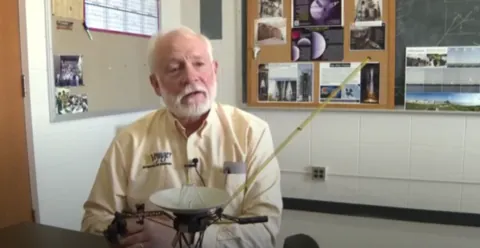
Voyager Probes Continue to Unravel Cosmic Mysteries Nearly 50 Years Later!
2024-11-08
Author: Yu
Introduction
Nearly five decades ago, NASA launched two groundbreaking spacecraft, Voyager 1 and Voyager 2, on an extraordinary mission to explore the outer gas giants of our solar system. This remarkable journey was made possible by a rare planetary alignment that occurs once every 176 years, allowing these spacecraft to use gravitational assists from each planet to seamlessly navigate their paths with minimal fuel consumption.
Voyager's Journey
As the Voyager probes traverse the cosmic void, they have ventured over 15 billion miles from Earth. To give you an idea of just how far that is, it takes about 23 hours for light and radio signals to make the journey one way. Amazingly, these probes are still sending back data that continues to shift our understanding of the universe!
The Role of the University of Iowa
The University of Iowa's Department of Physics and Astronomy plays a pivotal role in this ongoing mission. Among the instruments aboard the Voyager spacecraft is the Plasma Wave Subsystem, which meticulously measures the subtle waves within plasma fields surrounding planets and throughout space. This instrument has been instrumental in uncovering some of the most significant findings in space exploration.
Significant Discoveries
One of its notable achievements includes detecting the eerie sounds of lightning occurring on Jupiter—a phenomenon confirmed for the first time in the early 1980s. The instrument captured the descending whistling tones generated by the various electromagnetic waves produced by lightning strikes. Intriguingly, the technique used to analyze these waves is reminiscent of methods employed during World War II, when spies listened for sounds to gather intelligence on adversaries.
Dr. Bill Kurth's Contribution
Dr. Bill Kurth, a research scientist at the University of Iowa and a key figure in the development of the Plasma Wave instrument, has been active in monitoring data from the Voyager missions for nearly 50 years. Reflecting on his long-standing involvement, Dr. Kurth shared, “Every time I look at a new data file, I feel a rush knowing I'm observing something that no one has seen before.”
Endurance of Technology
Despite the aging technology, the Voyager probes have shown incredible endurance. Out of the nearly 10 original instruments onboard, only four remain operational. As power conservation measures ramp up to extend the spacecrafts’ lifespan, the University of Iowa’s Plasma Wave instrument continues to provide invaluable insights about our cosmic surroundings.
The Future of Voyager Probes
The future of the Voyager probes remains uncertain, but scientists posit that they may function until the early 2030s. Even after that, they will continue their silent voyage through space, likely surviving beyond our own star, the sun.
Conclusion
As humanity continues to gaze into the depths of space, the Voyager missions remind us that our quest for knowledge is timeless. The tantalizing data sent back by these stalwarts may hold the keys to unlocking even more secrets of our universe! Stay tuned to this incredible journey as it unfolds!


 Brasil (PT)
Brasil (PT)
 Canada (EN)
Canada (EN)
 Chile (ES)
Chile (ES)
 España (ES)
España (ES)
 France (FR)
France (FR)
 Hong Kong (EN)
Hong Kong (EN)
 Italia (IT)
Italia (IT)
 日本 (JA)
日本 (JA)
 Magyarország (HU)
Magyarország (HU)
 Norge (NO)
Norge (NO)
 Polska (PL)
Polska (PL)
 Schweiz (DE)
Schweiz (DE)
 Singapore (EN)
Singapore (EN)
 Sverige (SV)
Sverige (SV)
 Suomi (FI)
Suomi (FI)
 Türkiye (TR)
Türkiye (TR)